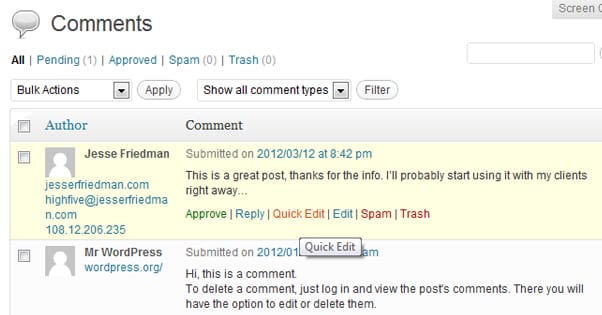50+ Blog Post Promotion Tips That Actually Build Traffic
Published by James Parsons • Content Marketing • Posted January 19, 2016 ContentPowered.com
ContentPowered.com
I’m tired of the same old analogy about Field of Dreams. Everyone references the “if you build it they will come” line and then tells you it’s not true. Right, we get it, you know one line from a movie that’s 26 years old. Half the bloggers you’re talking to right now weren’t even born when that movie came out. It’s not even the right quote!
Still, the point stands, even if the analogy is tired. People don’t just discover websites on their own, especially blogs. Websites need promotion, they need exposure, they need circulation. If you don’t give them that fuel, they can’t light up.
What you need is some solid blog promotion strategies. Places to share, methods to use, tools to run. That’s what I’m compiling here for you; as many as I can, so you have plenty of options.
Most of these are general enough that they will apply to any blog, but some will be specific enough they won’t work for all of you. That’s okay! You don’t need to put every single one of them to use. Just do as many of them as you can without spamming, wearing yourself out, or over-saturating your market.
Without further ado, here are our favorite and most effective blog post promotion tips to increase your traffic:
Producing Great Content
These tips are all about the foundation of your blog: your content. Without great content, you can’t bring in traffic and you can’t get people to stick around.
Great content can turn $10 of ad spend into lingering readers, whereas poor content can bounce $1,000 a day and leave you no better off.
- Figure out what your niche is missing and fill in the gaps. A lot of niches won’t have many visible gaps, so you might have to do some digging. It doesn’t matter if they’re not all hits; the few people you please will be worth it.
- Find content that is out of date or old and update it. This includes your old content if your site is older, and content from other sites that hasn’t been updated. Supplant old resources with newer, better ones.
- Find thin content and steal traffic with better versions. Adopt the “anything you can do I can do better” attitude and figure out where people are ranking with mediocre content. That’s an opportunity for greatness.
- Write list posts. Lengthy list posts give you a lot of space to cram in a lot of information, and you can use them to cover a variety of topics at once. Then you can use that list as a resource later.
- Use specific terms, don’t rely on generic appeal. Targeting 1,000 users with something they barely care about is nowhere near as good as targeting 100 users with something they really want. You can break up a general post into a bunch of more specific posts to cover those 1,000 people and more.
- Avoid clickbait to avoid annoyance. Clickbait is the realm of thin spammers, Buzzfeed, and George Takei. If you’re not a humor or clickbait-focused website – or if you run a legitimate business – you can’t get away with clickbait for long.
- Explore a negative perspective. Being contrarian is a good thought exercise, even if you do logically arrive at the generally accepted conclusion. You can also take a negative outlook and explore the dark side or down side to various trends.
- Write lengthy and valuable tutorials. If you know how to do something others might have trouble doing, write a tutorial. There’s a reason sites like eHow dominate search results.
- Publish content on a regular schedule. The more content you have and publish, the more opportunities you have to earn a high ranking, pull in traffic, and go viral on social media.
- Keep your own content as high above Google’s minimum thresholds as possible. Google is constantly upgrading what they consider the be the minimum amount of effort to be a good site, and you don’t want to be pushed aside in an update.
Boosting Engagement
Once you have a firm baseline, you need to capture your readers and get them to take action to benefit you.
Social shares, comments on posts and on social media, email registrations, referrals; they’re all the core way you can spread your sphere of influence.
- Make the first comment on your best posts.
- Seed comments with alternate accounts (sometimes.)
- Ask questions in your post and in your social shares.
- Offer numerous ways to go from one piece of content to the next.
- Write content as a response to other posts.
Sharing Your Content
The places you put your content once you’ve written it give you access to millions upon millions of people, the vast majority of whom will never see your posts.
Even so, everyone who sees a post through a social network who wouldn’t have visited your site normally is a beneficial bit of exposure.
- Post on Facebook. Pretty much everyone can run a Facebook page and be successful. There are over a billion active monthly users; your audience is sure to be represented. You just have to learn how to target them properly.
- Post on Twitter. Twitter is excellent for short-form engagement, direct conversations, and trend spotting. It’s also wonderful for dumping your links when you publish, so long as that’s not all you do.
- Post on Google+. Google+ is an often overlooked social network but it gives you a lot of benefits like faster indexing. Plus you’ll need to use it if you’re using YouTube or Google+ Places and other search extensions.
- Post on LinkedIn. Only some businesses can fit on LinkedIn due to the heavy B2B focus, but if you can market there, you can get a ton of great engagement.
- Send to your email list. If you’re not building your email list, you’re not taking advantage of all of your resources. A mailing list is one of the very few sources of traffic you can have that’s available independently of Google search ranking.
- Post a link on Reddit. Reddit is difficult to use for marketing because they hate being marketed to, so you need to participate in it as an organic user. As they say in their terms: “It’s okay to be a redditor with a website; it’s not okay to be a website trying to use Reddit.”
- Post an image on Instagram. Instagram loves visual content and it can get you a lot of engagement, but it’s not likely to funnel you much traffic unless your website content is similarly visual.
- Post an image on Pinterest. Pinterest is great for infographics, for graphical content, and for image-based representations of your content as a whole. If you can make a good “cover” for a blog post, you can post it on Pinterest.
- Post an image on Imgur. Imgur is much like Reddit, with many of the same caveats. If you’re obviously marketing, they’ll call you out and vote you down. If you’re clever, you’ll slip through as good viral content and end up posted everywhere.
- Run paid ads on all of these platforms. Paid advertising is very much worth your time and money, so long as you do it right. I recommend testing out each ad platform with a small budget before deciding where to focus your cash.
- Share with influencers on Triberr. Triberr is a niche social network made for thought leaders, influencers, and bloggers. If you can gain a presence on Triberr, you can have an instant source of great links throughout your industry.
- Share with millennials on Tumblr. Tumblr has a very specific type of audience and tends to focus a lot on humorous content, political content, social justice posts and pop culture. If you fit in that kind of niche, you can do very well.
- Take advantage of the minimalism of Ello. Ello has its ups and downs, but if you can gain a foothold, you can use it to great effect.
- Use foreign social networks like VK or Bebo. There are a lot of different foreign social networks, and there’s no way you’ll use them all properly. Only try if you have an audience present in a country that predominantly uses such a network.
- Add content to StumbleUpon. I don’t recommend paid discovery through Stumble, but you can certainly get some organic traffic from the site. Regardless, it doesn’t hurt you to add your content to their database.
Repurposing Your Content
Producing great content is hard, as is keeping a robust presence on a variety of sites. By taking your existing good content and repurposing it in other formats, you can reach other audiences with minimal effort.
- Turn blog posts into infographics. By distilling your content down to the base essence and points, you can make it very attractive for both sites like Pinterest and for any of the dozens of infographic aggregators you can submit your content to.
- Turn blog posts into explainer videos. Videos can be posted in several places. YouTube is the obvious one, but Facebook Video has gotten huge in the last few years, and you can always put it on a site like Vimeo while you’re at it.
- Turn blog posts into podcasts. Podcasts get you access to podcast aggregator sites and stores like iTunes. Plus, you have the blog post right there; you basically already have a script.
- Turn blog posts into slide decks. This can be as simple as chopping up an infographic or distilling a post into a PowerPoint-style outline. Slideshare is the premier site for sharing slide decks and can get you quite a bit of traffic, plus it’s great for SEO.
- Expand posts into ebooks. Your best posts can probably be expanded quite a bit. Take every salient point and write another paragraph or two about it. Expand on statistics. Take lists and expand them. Then slap a cover on it and sell it on Amazon.
- Consider translating your content into other languages. There are automatic WordPress plugins to do it for you, as well as services you can hire. Neil Patel uses Transposh and hit 82 languages for global reach.
- Compile data about posts and write a meta-analysis. Everyone likes a good case study, and if you have good, relevant data, people can use it and link to it for months or years to come. Bonus points if you can repeat the study every year; you become an industry institution.
- Take user suggestions, comments, and response posts and create updated posts. You can either edit in comments and your responses, or you can take their suggestions and write a whole new piece of content.
- Create roundup posts for your content and industry content. Common advice for social media is to share content from others in addition to your own; why not do it on your blog too? As long as you’re not stealing content wholesale, people will probably appreciate the link and mention.
- Turn list posts into tables of contents for many other posts. A post like this one you’re reading right now could easily have a link in every bullet point, leading to a post written solely about that topic. It’s a great strategy.
Producing Content on Other Sites
You don’t have to limit your production to sites you own or social networks.
You can find ways to contribute to other sites, earning links and a reputation as a thought leader in your industry.
- Get into guest posting on industry hubs. Guest posting specifically for SEO is a bad idea, but guest posting in general – to build a brand and contribute to other sites – is a great idea. Offer your expertise and services as a writer to people who accept guest posts.
- Participate in LinkedIn and Facebook Groups. This also includes any other social group you can think of. Closed groups can be great inclusive resources and communities for links and content sharing.
- Participate in Twitter Chats and Hashtag Discussions. Twitter’s chats and scheduled hashtag discussions can be excellent for a great deal of exposure beyond what you get just from posting.
- Answer questions on Quora. The Q&A site is like Yahoo Answers, only good, and full of people with a lot of experience and information to share.
- Post on industry relevant web forums. Forums aren’t great for marketing these days, but they’re still pretty good for building a reputation. Even better if you can make a branded forum for your own community, if it’s sizable enough.
Building Links
Links are the central pillar of how SEO works, because they’re the foundation of how Google determines value.
By building good links to your content, you increase the overall value of your site more or less permanently.
- Use expired domain marketing. Look for expired domains that are relevant to your industry and have some residual links and SEO value. Buy them and throw up a microsite – something like a landing page – and refer traffic to your site. Just make sure it’s not duplicate content or spam.
- Link to yourself with relevant comments. There’s a fine line between comment spam on other blogs and link building in a white hat way. How can you tell the difference? White hat comment links are incidental to the value you bring to the post, but are relevant if the user wants to know more.
- Make use of broken link building. Find existing links that lead to missing content, content that has moved, or content that is out of date. Message the webmaster with your version of the content and let them know their existing link is bad.
- Publish content with web syndicators. Syndicating content can be risky, and it can often do more to help the people publishing your work than it does to help you, but sometimes it can earn you significant traffic. Use with care.
- Link to influencers and let them know. Whenever you link to anyone, it’s good practice to shoot them a message and let them know you linked to them. The exception is if you link to them often enough you would basically be spamming them with notifications.
Attitude Adjustments
At the end of the day, even if you have great content and do everything right, you can still drive people away with a bad attitude. Remember you’re part of a community; be charitable and practice good values to keep in favor.
- Always be willing to help out others and offer free advice. The only people who jealously guard their secrets are the black hat affiliate marketers who worry about someone stealing their niche and undercutting them, or who worry about their techniques being discovered and penalized in Google.
- Take the time to contribute something of value in comments. People always appreciate a good comment, and I mean something more than just a basic “hey, thanks for writing this post.” Bring your experience, insight, data, or opinions to bear and get a conversation started.
- Address negativity in a polite and reasonable way. No one likes a business owner throwing a tantrum about a negative review. Don’t mock, insult, or berate your customers, even if they don’t like you. Instead, try to make things right as best you can.
- Don’t hold grudges if you’re rejected. If you refuse to sell or publish content on a site because it has rejected you in the past, you’re going to end up with a blacklist longer than there are sites left who will publish you. Sure, they’re in it for themselves; that doesn’t mean you can’t benefit.
- Thank influencers when they link to you. It’s just common courtesy.
So there you have it. Participate in conversations, be a knowledgeable and helpful person, share what you know, and publish great content. Share your content, keep up the engagement, and roll in the growth.












